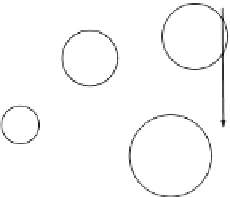Information Technology Reference
In-Depth Information
a
b
Proxy of S
1
Sc
Sc
Proxy of S
1
Sb
Sb
Proxy of S
1
Sa
Sa
S
2
S
2
S
1
S
1
Sd
Proxy of S
2
Sd
Fig. 6.6
(
a
) Iterative sensors movement and (
b
) proxy based approach
algorithm has calculated its target location. Static sensors construct a Voroni
diagram and listen to the mobile sensors' advertisements. After receiving an adver-
tisement, a static node records the embedded information and maintains a mobile
sensor list. Once a static sensor detects a sensing hole in its Voroni polygon, it
estimates the hole size and computes a bid accordingly. Then, from its mobile sen-
sor list, it chooses the closest one with the lowest base price that is smaller than the
bid, and sends a bidding message to that sensor. In the case that a mobile sensor
receives more than one bidding message from different static sensors, it chooses the
highest bid and sends a delegate message to the corresponding bidder. After receiving
the delegate message, the bidder becomes the proxy of the mobile sensor and
executes the relocation protocol on its behalf as if the mobile sensor had migrated
to the sensing hole. The approach addresses the issue of minimization of energy
consumption by letting the nodes move locally, but only after they have decided
whether their movement maximizes the coverage or not (Fig.
6.6b
). Even though
the main advantages of the proposed protocol are avoiding the multiple holes and
thus load balancing, it is complex for implementation and requires cooperative
computing of the sensors to determine their logical movement. The protocol is band-
width inefficient because of the frequent advertisement broadcasting. Additionally,
both bidding and proxy employ moving toward largest coverage holes.
6.3.1.3
Quorum-Based Approaches
Several
quorum-based
approaches are introduced in literature [
22, 25, 26
]. Ref.
[
22
] presents the original quorum-based approach, where filling the coverage holes
with cascade sensor movements is performed from cells with redundant sensors
toward cells with a lack of sensors. The protocol partitions the area in grids and
assigns a CH or responsible node in each cell. The CH will process the advertise-
ments and queries from the cells with redundancy and deficiency of sensors,
respectively (Fig.
6.7a
). This approach is described in more detail in the following
section, where the approaches which use different grid structures are classified.































Search WWH ::

Custom Search